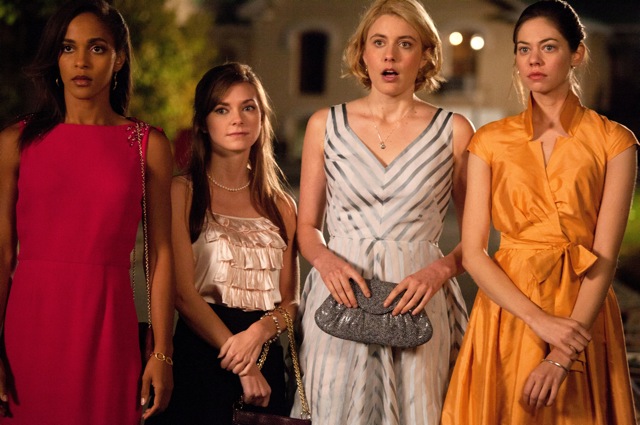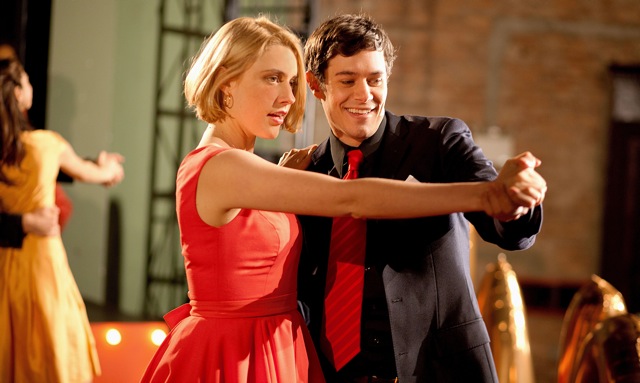CHICAGO – Patrick McDonald of HollywoodChicago.com appears on “The Morning Mess” with Dan Baker on WBGR-FM (Monroe, Wisconsin) on March 21st, 2024, reviewing the new streaming series “Manhunt” – based on the bestseller by James L. Swanson – currently streaming on Apple TV+.
Whit Stillman’s Wittily Precious ‘Damsels in Distress’ Grows Tedious
 Rating: 2.5/5.0 |
CHICAGO – The sly satires of Whit Stillman have cultivated a fan base that appears to consist largely of his fellow peers. Manhattan-based filmmakers such as Wes Anderson, Noah Baumbach and Lena Dunham have cited his subdued comedies as an influence on their own similarly mannerist yet considerably more accessible work. For many moviegoers, Stillman’s brilliantly constructed, emotionally distant pictures are easy to admire but difficult to like.
The young, upwardly mobile “urban haute bourgeoisie” that populate his films serve as the target for Stillman’s observational, deeply affectionate humor. These characters may have big vocabularies and even bigger egos, but they are ultimately no less vulnerable and naive than their fellow peers in the lower social classes. I’ll never forget the hilarious scene in Stillman’s best film, 1998’s “The Last Days of Disco,” where a group of twentysomethings utilize their long-winded skills of analyses to pick apart the intricacies of Disney’s “Lady and the Tramp.”
However, Stillman’s long-awaited fourth feature, “Damsels in Distress,” is the first one of his films that I can honestly hail as laugh-out-loud funny—at least for its first third. The writer/director’s colorfully worded zingers have lost none of their freshness and wit, yet they are given immeasurable punch by the peerless comic timing of his game young cast headed by “Greenberg” star Greta Gerwig. Exuding the ethereal dreaminess of Liv Tyler and the deadpan edge of Diane Keaton, Gerwig is a captivating screen presence. Stillman puts her bubbly spunk and crestfallen eyes to exquisitely good use in the role of Violet, a junior and would-be life force at an East Coast college that has recently turned co-ed. Violet leads a trio of girls on an impassioned mission to bring hope, dancing and cleanliness to the male-dominated campus while enticing students to visit her suicide prevention center with the promise of doughnuts. Gerwig is tremendously funny in scenes where her character’s condescension comes through when she’s supposedly at her most humble and well-intentioned. When one embittered student barks, “You think I’m going to kill myself and make you look bad,” Violet tenderly responds with the golden punchline, “I’m worried that you’ll kill yourself and make yourself look bad.” Violet’s need for control is so severe that she’ll openly welcome criticism but then shut out her critics before they have a chance to elaborate. Like the heroine of “Martha Marcy May Marlene,” Violet perceives herself as a “teacher and a leader,” yet in this case, her cult of choice is custom-made.

Megalyn Echikunwoke, Carrie MacLemore, Greta Gerwig and Analeigh Tipton star in Whit Stillman’s Damsels in Distress.
Photo credit: Sabrina Lantos, Courtesy of Sony Pictures Classics
As in Stillman’s debut effort, 1990’s gem “Metropolitan,” a privileged group of high-minded youth recruits a new member whose objectivity threatens to enlighten their warped sense of reality. On the heels of her memorable turn in “Crazy, Stupid, Love,” Analeigh Tipton is perfectly cast as Lily, the straightwoman with a flair for sanity not shared by her tentative BFFs. It’s not long before Lily’s infuriation starts to mirror that of the audience. Violet instructs her group that it is their mission to help students that are, in one way or another, inferior to the masses. Just as the straight-laced protagonist in Stillman’s interminable “Barcelona” proclaimed his preference for homely women, Gerwig insists that she is only interested in dating unattractive dim bulbs with untapped (or seemingly nonexistent) potential. Though Violet dedicates herself to helping complete strangers, it’s clear that she needs a great deal of help herself. After a while, the blissful charm of the early scenes devolves into a tedious series of forced affectations, leaving viewers in a state of perplexed detachment.
During the last hour of “Damsels,” I found it increasingly laborious to endear myself to a student body comprised of men who were dumber than a box of rocks and women whose brains appeared to have been imported from Pluto. Violet’s trio includes Heather (Carrie MacLemore), an adorable bubble-head whose restless brain has the irritating knack for getting hung up on insignificant details. She can’t understand why the name of her ex, Xavier, could be spelled with an “X” when Zorro is spelled with a “Z.” Her current boyfriend, Thor (Billy Magnussen), is unable to identify colors by name, and delivers a defiant monologue about his own self-worth that plays like the sort of SNL skit saved for the final minutes leading up to midnight. The doltish antics of Violet’s unfaithful boyfriend, Frank (Ryan Metcalf) are especially unfunny, and his scenes drag on to the point of torture. What did Stillman find appealing about these one-joke doofuses? Was this his attempt at paying homage to “Dude, Where’s My Car”?
Standing out from the testosterone-fueled pack is Fred (Adam Brody), a man obsessed with social standing whose deceitful nature proves to be a turn-on for Violet. They engage in a climactic, Fred Astaire-inspired dance number so poorly dubbed and awkwardly staged that it left me feeling depressed. Perhaps Stillman was attempting to recapture the exhilaration of “Disco,” which memorably ended with its lovestruck characters moving to the infectious rhythms of The O’Jays’ “Love Train.” In “Damsels,” the dance moves register as hollow posturing rather than delirious expressions of euphoria.

Greta Gerwig and Adam Brody star in Whit Stillman’s Damsels in Distress.
Photo credit: Sabrina Lantos, Courtesy of Sony Pictures Classics
So what is “Damsels in Distress” about at its core? I believe a large hint is revealed in the scene where Lily chastises modern media for favoring uniqueness over normalcy, inspiring members of her generation to make wildly forced attempts at being different. That statement certainly applies to Violet’s entourage, particularly Rose (the delightful Megalyn Echikunwoke), who visited England for six weeks and has subsequently insisted on speaking in a British accent at all times. Violet is so insecure that she fully embraces lies as a defensive shield. When she’s desperate to prove that others share her worldview, her fictional cousin Jay materializes to function as an optional vessel for her words. These perpetually aloof heroines are intent on playing false versions of themselves in order to achieve a higher sense of self, and over the course of a less-than-brisk 99 minutes, their act grows increasingly tiresome. Gerwig’s performance is nearly worth the price of admission alone, but even her immense likability can’t transcend the shortcomings of this script. It’s been 14 years since Stillman made his last feature film, and I’m confident that he’ll have better films in his future. Yet some viewers can only take so much hyper-stylized preciousness before they’re driven to ask the waiter for the check while excusing themselves with Woody Allen’s old line, “I’m due back on planet Earth.”
 | By MATT FAGERHOLM |



The message of the film
I think the thematic idea of Damsels is better illustrated by the aforementioned Zorro/Xavier dialogue. Violet explains to Heather that there are actually two Zorros, one who spells his name with z, and another who spells his name with an x. Unfortunately for Xorro, because he signed his name as “X”, people tended to think he was illiterate.
Its basically a parable about how one can assume a new identity to serve some kind of practical or fanciful purpose, but that new identity might be misunderstood just as easily as the “real you”.
This seems to be the ongoing theme played out in the movie. Each character is pretending to be something that they’re not, in some way or another. Likewise, their friends and acquaintances tend to misunderstand this made-up identity.
A lot of the comic dialogue is basically an ongoing discussion of this principle from different perspectives.
yes, this is very dry humor, but I think the movie is essentially asking the question how much do we reveal about ourselves via the ways in which we try and hide the truth?